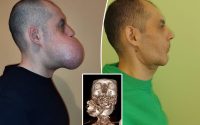Doctor reveals proper way to clean your ears to avoid injury
This is the way to be ear-responsible.
A UK doctor is sharing sound advice about how we should be cleaning our ears.
“How should you keep your ears clean? You don’t,” the 31-year-old general practitioner who goes by Dr. Sooj told his 58,700 TikTok followers last month.
“Your ears are self-cleaning,” the ear-thority explained in the 12-second TikTok, which has pulled in more than 18,400 views.
“You shouldn’t put anything smaller than your elbow in your ear,” the doctor continued.

“You can get a flannel and wipe around the outside of the ear, but if you’ve got any problems, then you need to see a doctor or nurse, and we’ll tell you what to do,” Sooj added.
A 2017 study by Nationwide Children’s Hospital in Ohio found that nearly 264,000 children visited US emergency rooms for cotton swab-related ear injuries between 1990 and 2010.
That works out to about 12,500 injuries a year, or about 34 a day.
Ear cleaning was the most frequently documented circumstance at 73%, followed by playing with cotton tip applicators at 10%.
“The two biggest misconceptions I hear as an otolaryngologist are that the ear canals need to be cleaned in the home setting and that cotton tip applicators should be used to clean them; both of those are incorrect,” Dr. Kris Jatana, the senior study author, said in a statement at the time.
“The ear canals are usually self-cleaning,” Jatana added. “Using cotton tip applicators to clean the ear canal not only pushes wax closer to the ear drum, but there is a significant risk of causing minor to severe injury to the ear.”

For his part, Sooj told Jam Press that “it’s quite common to see people in general practice with ear wax that has been impacted against their eardrums. [It can] lead to hearing difficulties, tinnitus, and even dizziness!”
A health care provider can remove excessive earwax with a long-handled spoon, forceps, irrigation or a suction tool.
Sooj also discourages ear candling, which involves placing a lit, hollow candle in your ear to try to remove wax.
“It’s been widely discredited,” Sooj said last month of the popular practice.


